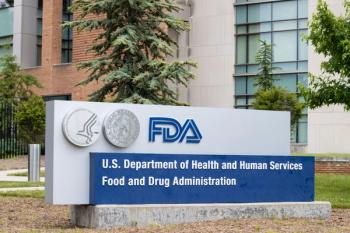
The Fine Arts of Finerenone Use in Heart Failure
Finerenone's approval by the FDA to treat type 2 diabetes–associated chronic kidney disease was supported by data from the phase 2 FIDELIO-DKD trial; now, the results of FINEARTS-HF show real-world application for patients living with heart failure with preserved ejection fraction or mildly reduced ejection fraction.
After final results were announced1 on September 1 at the
The nonsteroidal mineralocorticoid receptor antagonist (MRA) would join steroidal MRAs already approved to treat heart failure—spironolactone (Aldactone; Pfizer),2 and eplerenone (Inspra; Viatris),3 and the sodium glucose co-transporter 2 (SGLT-2) inhibitor empagliflozin (Jardiance, Boehringer Ingelheim/Eli Lilly)4—as well as add to the treatment armamentarium in the space but at the same time fill a treatment gap for patients with HFpEF or HFmrEF, for whom there remains an unmet need, said FINEARTS-HF principal investigator Scott Solomon, MD, professor of medicine, Harvard Medical School, and senior physician and director of noninvasive cardiology, Brigham and Women's Hospital. Finerenone is a more selective agent for the MR receptor with a shorter half-life that has “a more balanced distribution between the heart and kidneys,” he explained.
SGLT-2 inhibitors are the only class I medication approved to treat patients with these 2 subtypes of heart failure, Solomon added.
Finerenone is only approved in the US to treat 4 risks associated with type 2 diabetes–associated chronic kidney disease: sustained estimated glomerular filtration rate (eGFR) decline, cardiovascular death, nonfatal myocardial infarction, and hospitalization for heart failure.5 The MRA works by inhibiting the effects of mineralocorticoids on the heart and kidneys and reducing activation of the renin-angiotensin-aldosterone system (RAAS) pathway, which has a positive impact on blood pressure and fluid retention.6
FINEARTS-HF Study Design
In the phase 3 double-blinded placebo-controlled trial, 6001 patients from 635 sites in 37 countries were randomized 1:1 to placebo (n = 2998) or minimum and maximum finerenone doses based on eGFR (n = 3003):
- 60 mL/min/1.73m2 or below: 10 mg or 20 mg (maximum dose)
- Above 60 mL/min/1.73m2: 20 mg or 40 mg (max dose)
Patients were uptitrated to the maximally tolerated dose if their serum potassium fell below 5 mmol/L and their EGFR by more than 30%. Study visits took place at month 1, every 3 months for the first year of treatment, and every 4 months thereafter. To participate, patients had to have symptomatic New York Heart Association (NYHA) class II-IV disease with an LVEF of at least 40%, elevated natriuretic peptide levels, structural heart disease, and been administered diuretics in the 30 days prior to randomization; they could be ambulatory or currently or recently hospitalized. Potassium levels above 5 mmol/L, an eGFR above 25 mL/min/1.73m2, MRA use in the month before randomization, and history of peripartum, chemotherapy-induced, or infiltrative cardiomyopathy precluded participation. The study’s completion data was June 14, 2024.7
Secondary outcomes of interest were total heart failure events, NYHA disease class improvement to 12 months, all-cause mortality, renal composite end point, all-cause mortality, and change in Kansas City Cardiomyopathy Questionnaire Total Symptom Score (KCCQ-TSS) from baseline to 6, 9, and 12 months. KCCQ-TSS and NHYA improvement were tested simultaneously, and the renal endpoint encompassed 3 measures:
- Sustained decrease in eGFR of at least 50% relative to baseline
- Sustained eGFR decline of less than 15 mL/min/1.73m2
- Dialysis or renal transplant
The primary outcome of interest was a composite measure of cardiovascular death and total heart failure events (first and recurrent for heart failure–related hospitalization and urgent heart failure visits).
Patient Characteristics
A total of 2993 patients from each cohort received treatment, and 20% of patients from the treatment group and 21% from the placebo group discontinued treatment at the end of FINEARTS-HF; vital statistics were available on all remaining patients.
“This is a very characteristic patient population for heart failure with mildly reduced and preserved ejection fraction,” Solomon said when speaking of patient characteristics.
The mean (SD) age of the patient groups was 72 (10) years, and each group had mostly male (45%, finerenone; 46%, placebo) and White (79% each group) patients with NYHA class II disease (69% of each group). Baseline measures included KCCQ-TSS of 68 (24) and 67 (24) for the finerenone and placebo groups, respectively; LVEF of 53% (8%); systolic blood pressure of 130 (15) and 129 (15) mm Hg; median NT-proBNP of 1052 and 1028 ng/L; eGFR of 62 (19) and 62 (20) mL/min/1.73m2; and urine albumin-creatinine ratios of 18 and 19 mg/g. Most patients were on loop diuretics (87% each) or beta-blockers (85% each), and had a history of hypertension (88%, finerenone; 90%, placebo) or prior heart failure hospitalization (60% and 61%, respectively).
KCCQ-TSS is measured on a scale of 0 to 100, with higher scores indicating less symptom severity and better overall quality of life.8
Final Results
This was the first trial of an MRA in patients with left ventricular ejection fractions (LVEFs) about 40% to meet is primary end point, as well as the first of a RAAS inhibitor to do so, according to Theresa McDonagh, MD, FRCP, FESC, consultant cardiologist, King’s College Hospital, London, and professor of heart failure, King’s College, London, who discussed the results following Solomon.
There was a 16% reduced risk of cardiovascular death and total heart failure events (rate ratio [RR], 0.84; 95% CI, 0.74-0.95; P = .007), which was statistically significant, for an absolute rate reduction of 3.3 per 100 person-years (PYs). Total events were 1083/14.3 per 100 PYs and 1283/17.6 per 100 PYs in the finerenone and placebo groups, respectively.
Risk of total heart failure events fell by 18% with finerenone compared with placebo (RR, 0.82; 95% CI, 0.70-0.94; P = .006), and although cardiovascular death and all-cause death both saw a drop of 7% vs placebo, these results were not considered statistically significant.
This efficacy was consistent across the prespecified subgroups of age, gender, race, BMI, LVEF, region, NYHA class, index heart failure events, systolic blood pressure, eGFR, serum potassium, NT-proBNP, urine albumin-creatinine ratio, atrial fibrillation per ECG, diabetes status, and and use of ACE, angiotensin receptor neprilysin, or SGLT-2 inhibitors angiotensin receptor blockers.
“There was no evidence of heterogeneity across any of the prespecified subgroups,” Solomon emphasized.
There was an insignificant improvement in renal events with finerenone vs placebo, at 2.5% vs 1.8% (HR, 1.33; 95% CI, 0.94-1.89), respectively; 18.6% and 18.4% improvements in NYHA class at 12 months (odds ratio, 1.01; 95% CI, 0.88-1.15); and 8- and 6.4-point improvements in KCCQ-TSS (P < .001). Finerenone was well tolerated, and although this group had a higher rate of hyperkalemia (elevated potassium), no patients died as a result.
These findings were published simultaneously in the New England Journal of Medicine.9
“There's no therapy yet that has been shown to reduce mortality per se in HFmrEF and HFpEF; even SGLT-2 inhibitors did not do that, and that's partly because the event rates for mortality are simply too low to be able to show in the time course of these trials. You'd need to do much larger trials or wait much longer to see mortality benefit,” Solomon said during a press conference at ESC. “But we know that reducing morbidity in this way, reducing hospitalizations for heart failure, will likely lead to reduced mortality in the future if you wait long enough, as is the case in other conditions.”
References
1. Solomon S. FINEARTS-HF: finerenone in heart failure with mildly reduced or preserved ejection. Presented at: ESC Congress; August 30-September 2, 2024; London, England.
2. Center for Drug Evaluation and Research. Spironolactone approval letter. FDA. August 20, 2001. Accessed September 1, 2024. https://www.accessdata.fda.gov/drugsatfda_docs/anda/2001/40-424_Spironolactone_Approv.pdf
3. Center for Drug Evaluation and Research. Eplerenone approval letter. FDA. October 7, 2003. Accessed September 1, 2024. https://www.accessdata.fda.gov/drugsatfda_docs/nda/2003/21-437S002_Inspra_Approv.pdf
4. US FDA approves Jardiance for the treatment of adults with chronic kidney disease. News release. Eli Lilly. September 22, 2023. Accessed September 1, 2024. https://investor.lilly.com/news-releases/news-release-details/us-fda-approves-jardiancer-treatment-adults-chronic-kidney
5. Center for Drug Evaluation and Research. Finerenone approval letter. FDA. July 9, 2021. Accessed September 1, 2024. https://www.accessdata.fda.gov/drugsatfda_docs/nda/2021/215341Orig1s000Approv.pdf
6. Marcath LA. Finerenone. Clin Diabetes. 2021;39(3):331-332. doi:10.2337/cd21-0050
7. Study to evaluate the efficacy (effect on disease) and safety of finerenone on morbidity (events indicating disease worsening) & mortality (death rate) in participants with heart failure and left ventricular ejection fraction (proportion of blood expelled per heart stroke) greater or equal to 40% (FINEARTS-HF). ClinicalTrials.gov. Updated July 3, 2024. Accessed September 1, 2024. https://clinicaltrials.gov/study/NCT04435626
8. Spertus JA, Jones PG, Sandhu AT, Arnold SV. Interpreting the Kansas City Cardiomyopathy Questionnaire in clinical trials and clinical care: JACC state-of-the-art review. J Am Coll Cardiol. 2020;76(20):2379-2390. doi:10.1016/j.jacc.2020.09.542.
9. Solomon SD, McMurray JJV, Vaduganathan M, et al. Finerenone in heart failure with mildly reduced or preserved ejection fraction. N Engl J Med. Published online September 1, 2024. doi:10.1056/NEJMoa2407107
Newsletter
Stay ahead of policy, cost, and value—subscribe to AJMC for expert insights at the intersection of clinical care and health economics.








































